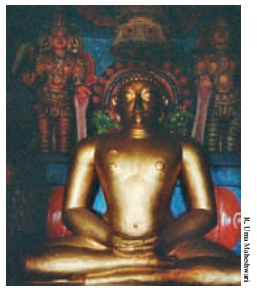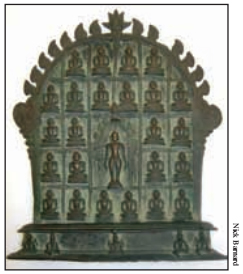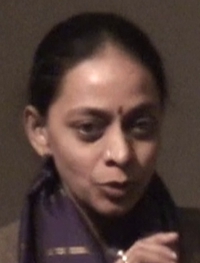
Centre of Jaina Studies Newsletter: SOAS - University of London
The subject of this report concerns one of my areas of research on the collections in London supported by a fellowship from the Nehru Trust for the Indian collections at the Victoria and Albert Museum. This is part of a larger project on the history of the Tamil Jaina community.1 By 'relational', I mean the kind of personal identification with the yakṣī that I observed among women in particular. It resembles a phenomenon of bhakti, relating to a personal god-concept at an emotional level.
One of the most distinguishing features of Tamil Jainism is the worship of the yakṣī (and in rare cases, the yakṣa) within the structural edifice of the Jaina temple complex. Among the most popular yakṣīs in Tamil Jaina temples are Padmāvatī, the yakṣī of Pārśvanātha, and Ambikā locally referred to as Dharumadevī or Kūṣmāṇḍinī, the yakṣī of Neminātha. Of the two, Ambikā is by far the most popular in Tamil Nadu, and her worship is older than that of other yakṣīs as temples dedicated to Neminātha in Tamilnadu are older and more numerous than the ones dedicated to other tīrthaṅkaras.
According to Padmanabh S. Jaini (1991:193), "Ancient Jaina texts are silent about the status of the yakṣas (or yakṣīs) within their religious fraternity...". M.N. Tiwari (1989:21) notes that "the earliest archaeological evidence... shows that Ambikā does not appear in Jaina worship prior to AD 550..." He further points out: "The worship of Ambikā started as early as in the 6th century AD and at least up to 9th century AD she was carved in association with Ṛṣabhanātha, Pārśvanātha and Neminātha. (And) her more distinctive iconographic form was first visualised towards the close of the 8th century AD..." (ibid. 23).
Authored by Iḷanko-aṭikal, a Jaina, the ancient Tamil text Cilappatikāram mentions yakṣī (iyakki) worship at a temple referred to as icakkiyammaṉ koil. Inscriptional records mentioning yakṣī worship in Tamilnadu have been found at Pañcapāṇḍavarmalai, Tirumalai, Poṉṉūr (North Arcot district), Aivarmalai, Tiruchānātrumalai and Kaḻugumalai (Madurai district) among others.
Tiwari states, elsewhere, that "There is bulk of iconographical and archaeological evidence to show that in the Tamil country, the yakṣī was accorded an independent status and raised to a very superior position, almost equal to that of the Jina. In some instances the worship of yakṣī appears to have superseded and overshadowed even that of a Jina himself" (Tiwari 1983:58-59).
Among the places showing prominence of the yakṣī image in iconographic terms are Ānandamaṅgalam (identified variously as Siddhāyikā, and Ambikā), Pañcapāṇḍavarmalai (North Arcot, Poṇiyakkiyār, golden yakṣī), Āṇaimalai and Seṭṭipoḍavu hill (Maṇdurai district), Tiruparuttikuṉṟam (Jinakanchipuram, Chengleput district, Ambikā), Kaḻugumalai (Tinnevelli district, Ambikā), and Karandai (Cheyyar taluk, Kanchipuram district, Dharumadevī).

Pārśvanātha with attendant deities-Karandai.
Incidentally, the Tamil Jainas believe that the Ambikā image in the Tiruparuttikuṉṟam temple was originally part of the Kāmākṣi temple complex at Kanchipuram which, according to them, was a Jaina temple later converted into a Śaiva temple. Ambikā in this temple is portrayed as one holding a mango leaf, a child and a staff. She is seen as a powerful deity in her own right and granter of boons.
The story of Ambikā is most popular with the Tamil Jainas both in terms of her origins as well as her 'interventions' in holding aloft the Jaina faith, or doctrine.
Her story, which appears in the Śrīpurāṇam, a text found in all Tamil Jaina households, lives in the popular memory of the Tamil Jainas. The story goes like this:
Agnilā was the wife of a brahmin named Somasarma from north Girinagara, and together they had two sons. Once during a ritual offering to the departed ancestors (śrāddha) Somasarma went to bathe in the river with his relatives. In the meantime, a Jaina monk passed by his house and Agnilā gave him some of the food that was meant for the Brahmins. When Somasarma returned and heard of this, he was furious, and accused his wife of being unchaste. Dejected, she left her house with her two children and sought refuge in the forest with a Jaina mendicant. Later, a repentant Somasarma followed her to the forest (with a burning torch of flame in some versions) with the intention of bringing her back; but seeing him thus, in her fear Agnilā jumped into a well, leaving her children behind. She instantly became a yakṣī, named Ambikā. In his despair Somasarma too gave up his life and was reborn as her mount, the lion. Ambikā became the protective deity of Neminātha (or Nemi) tīrthaṅkara.
The Tiruparuttikuṉṟam temple Sangīta Maṇṭapam (a corridor with musical pillars) has paintings depicting the story of Agnilā. As noted by Tiwari (1989: 131f.), "The rendering of the figures of Ambikā in the narrative of Agnilā is interesting since they show her without lion mount and āmra-lumbi."
Ambikā's story is intriguingly similar to that of the Śaiva saint poet Kāraikkāl Ammaiyār. Scholars are of varied opinion regarding the influence of one over the other. Both are stories of ordinary housewives turning into a 'supernatural' or other-worldly women the chaste wife Agnilā turning into Ambikā yakṣī, and another chaste woman, Punitavati turning into Kāraikkāl Ammaiyār, a Śaiva bard/saint, symbolically discarding her clothes and adornments. V. Vedachalam (1989: 89-93) and few other Tamil scholars made note of this striking similarity and opined that the Jaina story influenced the Śaiva one, which is of a later period. Kāraikkāl Ammaiyār is said to have lived between the time of the Śaiva bards Appar and Gñānasampantar. Her story is narrated in the Tiruniṉṟacarukkam section of Cekkiḻār's Periyapurāṇam:
Punitavatī belonged to a merchant family and was married to Paramadattan, son of a judge in Nāgapattiṇam. His friends once gave him two mangoes which he sent over to her. Meanwhile a Śaiva mendicant passed by their house and Punitavatī gave him one of the mangoes to eat. That night after dinner Paramadattan asked for the mango. Finding it delicious, he asked her for the second one. But she had given it already to the mendicant. She prayed to Śiva and he blessed her with a mango. Paramadattan found its taste heavenly and, deciding to test her, asked for another, which she similarly produced. Fearful of her supernatural powers, he abandoned her and married another woman. Dejected, Punitavatī went to Kailāśa, and sought a boon to become a pey, a possessing spirit. Śiva granted her the boon and she thus became Ammaiyār of Kāraikkāl (a place near present day Pondicherry).
According to Vedachalam, the story of Ambikā yakṣī is the older of the two.
While the story of Ambikā's genesis forms part of the Jaina textual tradition and perhaps makes a sort of simpler passage into iconographic rendition, there are some other legends in popular memory that do not see representation in iconographic features of Ambikā. In this sense, iconographic studies tend to remain confined to descriptive elaboration. It is difficult to understand a sculptural representation or any physical rendition outside of its social, cultural or even purely geographical context - the last being relevant to studies of art pieces in a museum context. For instance, the story narrated below.

Adinātha with Yakṣīs, Karandai
According to a local legend, part of popular Tamil Jaina narrative at Tiruppaṇamūr-Karandai (the twin villages in Cheyyar taluk), the yakṣī of the Karandai temple, Dharumadevī (Ambikā) helped the sage Akaḷanka (Skt. Akalaṅka), who according to the Tamil Jainas, belonged to this village, in a debate the Buddhists that was held in the village. The Buddhists and Jainas debated to determine who would stay on in that village and who would leave. The debate lasted for ten days. Akaḷanka almost lost his wits trying to win over the Buddhists. Despondent, he prayed to the yakṣī Dharumadevī at the Karandai temple for assistance. She appeared before him and said to him, "Tomorrow, ask the man who puts the first question to you to repeat the same; there is a goddess in an urn (kalaśam) with the Buddhists who is helping them. Her power will weaken when he repeats his question." Akaḷanka did as he was told and finally won the debate on the tenth day. The Buddhists accepted their defeat and left the village forever.
The worship of yakṣīs in Tamil Digambara Jainism needs to be seen within the evolution of temple worship in Tamilnadu. Worship of the image of tīrthaṅkaras and their associate yakṣīs gradually gave way to worshipping yakṣīs as independent deities. In the temple at Karandai, Dharumadevī yakṣī has a separate shrine, with steps leading up to it, within the temple complex. The tīrthaṅkaras have their own individual shrines as well. Similarly, in Tiruparuttikuṉṟam the yakṣī shrine is an individual shrine dedicated to her. Goddess worship in Tamilnadu is known to be one of the oldest forms of worship and goddesses such as Koṟṟavai are mentioned in the Cañkam works of the early centuries BCE. This basic cultural ethos did have its influence on the development of yakṣī worship in Jaina temples.
I was witness to one aspect of yakṣī worship at the old Jaina temple at Perumpokai (ancient Perumpukaḻ) where the women were led by the chief pontiff of the Jaina maṭha (maṭhātipati) in offering worship to the yakṣī Kūṣmāṇḍinī / Ambikā. The form of worship was similar to brāhmaṇical goddess worship, offering kumkum (vermillion) powder and flowers, with the Kūṣmāṇḍinī stotram being recited "śrīmat kūṣmāṇḍinī devī ambā ambālikā, yaje gandham graṇṇa graṇṇa... puṣpam graṇṇa graṇṇa..." ([we] make offerings to Śrīmat Kūṣmāṇḍinī Devī, ambā, ambalikā, sandal...flowers..."); and the name of the goddess a thousand times. Following this was the recitation of a Tamil poṟṟi (eulogy) in the name of Kūṣmāṇḍinī as well as the religion of the Jina. The ritual seems to be of a much later origin, however.

Tamil Jaina women gathered for yakṣī worship at the temple, Mallinātha svāmi Jinālaya, Perumpukai (ancient Perumpukaḻ)
Tamil Jaina women relate to the yakṣī more personally than they do to the tīrthaṅkara. Tīrthaṅkara worship is filled with awe, reverence and some 'distance'. On the other hand, the yakṣī is the 'ammaṉ' (mother, as Tamil women generally refer to goddesses) from whom it was easier to seek boons while the tīrthaṅkaras, beyond this-worldly attachments, are also by extension beyond matters of granting boons to the laity. They worship tīrthaṅkaras as perfect beings, and for self-realisation, keeping them outside the purview of their everyday struggles.
The collections of the Victoria and Albert Museum offer no representations of independent yakṣī figures from Tamil Nadu, or even South India. However, there is a stone image of Pārsvanātha accompanied by the yakṣī Padmāvatī and the yakṣa Dharaṇendra from the Deccan dated 12th century CE. But I would make mention of one of the interesting discoveries made in my research of the yakṣī at the V&A.
There is a fascinating bronze of 24 tīrthaṅkaras (from the Mackenzie collection) carved around one central figure of Pārśvanātha with five seated images of yakṣa/ yakṣīs carved below; these are possibly Cakreśvari-Gomukha, DharaṇendraPadmāvatī (in pairs on the left and right side of the panel) and Ambikā in the centre, though the attributes of the yakṣa / yakṣī figures are not well carved out because they are really small in proportion. The seated yakṣī at the bottom in the centre is most likely Ambikā. But there are two lion figures carved on her right and her left, and not as her mount, as is usually the case. This piece presumably once part of the pañcaparameṣṭhi group of ritual objects in a Jaina temple - is most likely from the Madras Presidency where Mackenzie 'discovered' a distinct community of Jainas.
The yakṣī image and worship within Tamil Jainism needs further research, particularly into the relational aspect of women vis-à-vis the yakṣī within ritualistic temple worship. Most work so far has concentrated on elaboration of the descriptive features of these 'attendant deities' within the larger Jaina tradition. A closer look at the evolution of non-Jaina mother goddess shrines in the same areas as the Jaina temples would be fascinating in terms of understanding the larger 'Tamil' cultural ethos and its subtle or obvious influences on the iconography and ritual aspects of Jaina yakṣī worship.
R. Uma Maheshwari gained her PhD at JNU New Delhi. Her focus of research is the social history of the Tamil Jaina community. She is currently the Nehru Scholar at the V&A and visiting scholar at the Centre of Jaina Studies at SOAS.
References:
Jaini, Padmanabh S., 'Is there Popular Jainism?', Humphrey, Caroline and Carrithers Michael, eds., The Assembly of Listeners: Jains in Society, Cambridge University Press, Cambridge, 1991, pp. 187-199.
Tiwari, Maruti Nandan P., Elements of Jaina Iconog raphy. Indological Book House, Varanasi, 1983.
Tiwari, Maruti Nandan P. Ambikā in Jaina Art and Literature, Bharatiya Jnanpith, New Delhi, 1989.
Vedachalam, V., Iyakki Vaḻipāḍu (Tamil), Agaram Printers, Madurai, 1989.

Mackenzie Collection Bronze Musuem No: 448(IS) Courtesy of the Victoria and Albert Museum
 Dr. R. Uma Maheshwari
Dr. R. Uma Maheshwari